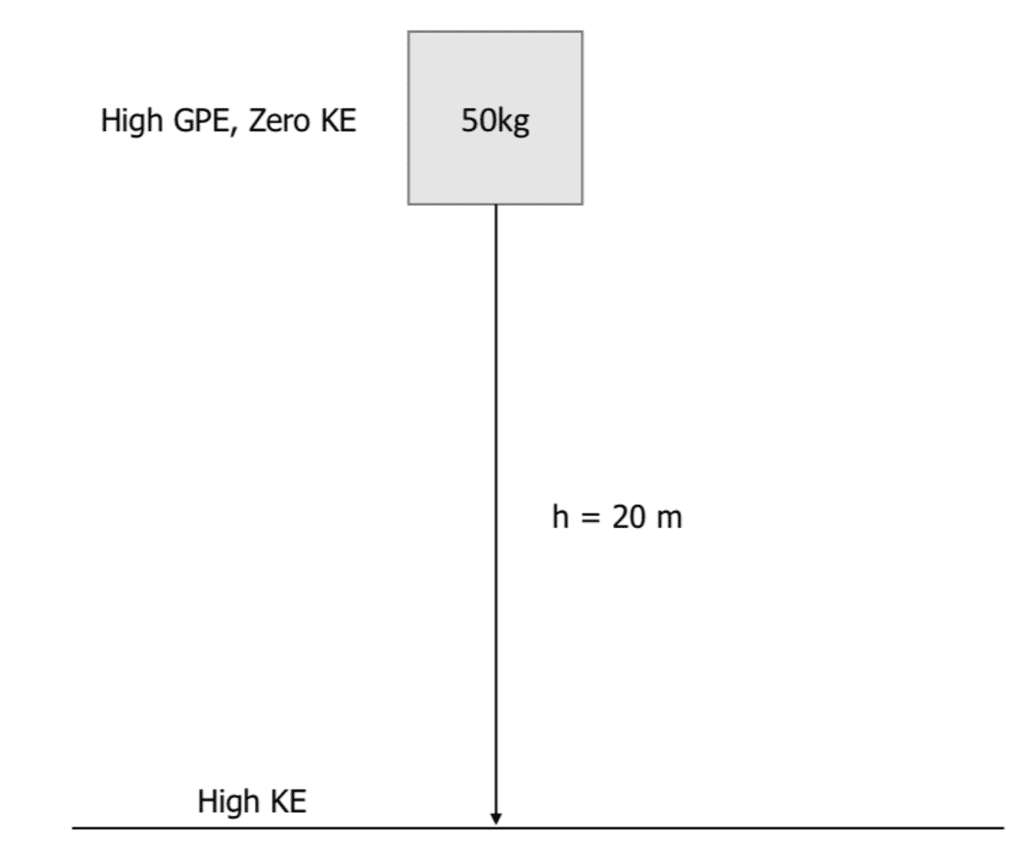Conservation of Energy
Conservation of Energy Revision
Conservation of Energy
Energy can take many forms around us. It gives objects the ability to do everyday things like produce heat, move, make sounds etc. This section looks at the different energy types you need to recall and the transfer of energy from one form to another.
Law of Conservation of Energy
The law of conservation of energy states “energy cannot be created nor destroyed, only transferred from one form to another”.
Therefore, in a closed system the total energy will remain the same. However, it may change from one energy form to another.
A closed system is a group of objects or devices that work together without the input of any energy or power from external sources.
Energy Types
There are several forms of energy that we need to know, describe and give examples of. These can be summarised as:
- Kinetic (KE) – the energy store of an object that is moving with a specific mass at a given velocity.
- Gravitational Potential (GPE) – the energy store an object has due to its mass being held at a height above the ground.
- Elastic (EPE) – the energy store a stretched or compressed object has due to its elastic deformation.
- Chemical – the energy stored in the bonds holding a chemical together.
- Nuclear – the energy stored in the nucleus of an atom.
- Internal (Thermal) – the energy stored inside an object due to its temperature.
Kinetic and Gravitational Potential Energy
Kinetic energy is the energy store an object has due to its mass and velocity. It is given by the equation:
E_{KE} = \dfrac{1}{2} \times m \times v^2
- E_{KE} is the kinetic energy in joules \left(\text{J}\right)
- m is the mass in kilograms \left(\text{kg}\right)
- v is the velocity in metres per second \left(\text{ms}^{-1}\right)
Gravitational Potential Energy is the energy stored by an object by its mass being held at a height above the ground. It is given by the equation:
\Delta E_{GPE} = m \times g \times \Delta h
- \Delta E_{GPE} is the change in gravitational potential energy in joules \left(\text{J}\right).
- m is the mass of the object in kilogram \left(\text{kg}\right).
- g is the gravitational field strength in Newtons per kilogram \left(\text{N/kg}\right). On earth the gravitational field strength is 9.81 \: \text{N/kg}.
Often objects held at a height fall to the ground. In this instance the object transfers its gravitational potential energy (GPE) store to kinetic energy (KE).
Example: A 50 \: \text{kg} mass falls from a height of 20 \: \text{m}. Describe its energy transfer and calculate the velocity of the object as it hits the ground.
[3 marks]


The energy transfer in this example is the object’s GPE converting to KE. In reality, small quantities of heat and sound would be produced but we are often told these are negligible and can be ignored.
As GPE converts to KE, assuming 100 \% efficiency, we can conclude;
\text{GPE (at the top)} = \text{KE (at the bottom)} as all the GPE has transferred to KE.
Therefore:
m \times \ g \times \Delta h = \dfrac{1}{2} \times m \times v^2
v^2 = \dfrac{m \times g \times \Delta h}{\dfrac{1}{2} \times m}
v^2 = \dfrac{2 \times m \times g \times \Delta h}{0.5 \times m}
v^2 = \dfrac{2 \times \textcolor{2730e9}{50} \times 9.81 \times \textcolor{cf2929}{20}}{0.5 \times \textcolor{2730e9}{50}}
v = \sqrt{392.4} = 19.81 \: \text{ms}^{-1}
Conservation of Energy Example Questions
Question 1: A battery powered bike can be considered as a closed system when it is not on charge. Describe what is meant by a closed system.
[1 mark]
A closed system is a device or group of devices that have no external energy input.
Question 2: A 72 \: \text{kg} person falls from a height to the floor. When they hit the floor their velocity is 8 \: \text{ms}^{-1}. What height did the person fall from?
[3 marks]
Question 3: Describe the energy changes of a bouncing ball that is dropped and continues to bounce until rest.
[3 marks]
- The ball starts with all GPE and no KE as it is held off the ground.
- When the ball is dropped, its GPE transfers to KE until it reaches the floor. When the ball bounces, it loses some energy to the surroundings such as heat and sound. It bounces up transferring its KE back to GPE but does not reach the same height due to energy dissipated to the surroundings.
- This continues until the ball has lost all of its energy to the surroundings.
Conservation of Energy Worksheet and Example Questions
Work, Energy and Power Questions
A LevelOfficial MMEYou May Also Like...

MME Learning Portal
Online exams, practice questions and revision videos for every GCSE level 9-1 topic! No fees, no trial period, just totally free access to the UK’s best GCSE maths revision platform.